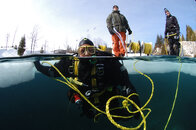For starter, you will need a dome port, of at least 8" if you can, a very wide lens (between 100 to 180 degree of field of view) I typically move the focus target in my viewfinder to the bottom part, you want to focus on the submerged virtual image of the dome port and then get your background with depth of field, try shooting in the f/11 or smaller aperture to get as much depth of fiel as possible.
A larger dome will give you a more pleasing, thinner water line and make it easier to reach the front to back focusing zone, focusing on the virtual image will insure that your principal subject is in focus, the background can be soft, it will not be as damaging as if the main subject was out of focus!
Also choose subject as close as possible to the surface and to you, the deeper in the water the subject, the bigger the gap in exposure between the topside and undewater. A difference from 3ft to 6ft can be huge in your final exposure.
If your dome is glass, then you can use Rain-X to make the droplet fall off faster, if it acrylic, then you can use Raincoat (most biker's shop will have it or something similar, most important, it is safe for acrylic) in a pinch, Pledge furniture polish is great, but does not last all day (it does make your dome smell godd on the other hand

Can you let me know what you have on hand already (dome/size, lens, camera etc.) its easier to figure out with every thing on the table.
you can use strobe, but I would use them as a last resort, they weight the rig considerably and everytime you try and lift the housing out, then you end up going down (good O'le Archimedes at work here), strobes only worsen the matter.
Also try to stay close to your subject and when ready, lift the dome out of the water ever so slowly, in order to let droplets slides as much as possible, then shoot the crap out of the situation (best put your camera in continuous high for the shooting frame rate, even more so if not using strobes), Focus I use AF-S (on my Nikon) and once in focu, i lock it with the rear AF-L button/lever.
if you can, then add some buoyancy material under the housing to make it easier to keep the top half out of the water. I actually made myself a dedicated platform for over/under shots.
even if shooting shallow I like to have my BCD on and inflate it (with the mouth inflator) this help preventing from going under as you lift the housing up.
there you go, that is all I can think of for now.




